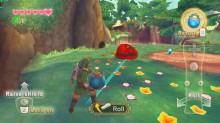Should Skyward Sword Give Players More Control Options?
Posted on November 21 2011 by Djinn
 The folks at Destructoid have written a new article discussing the control scheme of Skyward Sword and how that affected the review score last week. The article mostly comes as an explanation as to why the reviewer gave the game a 9.5 rating. He states that there was some criticism about the grade he gave so this article was an addition to his review so he could fully explain just why he thought that forcing a control scheme on players swawed his opinion.
The folks at Destructoid have written a new article discussing the control scheme of Skyward Sword and how that affected the review score last week. The article mostly comes as an explanation as to why the reviewer gave the game a 9.5 rating. He states that there was some criticism about the grade he gave so this article was an addition to his review so he could fully explain just why he thought that forcing a control scheme on players swawed his opinion.
That’s why they hate motion controls so much. Where standard button controls are something their muscle memory has fully embraced, motion controls are still a relatively new and awkward thing to adjust to. Even though many of the motions in Skyward Sword only require a flick of the wrist (or the elbow at the very most), the game’s controls are still likely to distract and annoy them.
This brings us to Skyward Sword, a game that seems to try to have it both ways but isn’t quite willing to go the extra mile to get there. According to certain reviews, the game’s motions controls have clearly taken at least one person out of the game. Now, as the video from TheBitBlock above clearly demonstrates, to fault the game’s controls for your inability to play it properly is an inaccurate assessment. That would be like giving a bad review to a perfectly good basketball because, every time you try to get it in the hoop, it bounces off the backboard. Good reviewers would know when it’s their fault, not the game’s, for their inability to enjoy it. That’s often not true of reviews of motion-controlled games. A lot of reviewers fail to understand that if a motion-controlled game works some of the time, then that means that it would work all the time if they were playing it properly. I could go on about that topic, but I’ll save it for another time.
In addition to being able to differentiate between personal flaws and a game’s flaws, it’s also their job to speak from their heart as well as their head. Though I felt like Skyward Sword was a perfect 10, I thought that the game was too potentially alienating to be considered flawless from a design perspective. To get a 10/10, the game has to give all players everything they could possible want or expect out of a title. The forced motion controls are just enough to keep Skyward Sword from getting there.
The fact that the Wii U exists says that Nintendo understands how much players appreciate being provided with control of how they experience their games. The same goes for the 3DS and its ability to turn off the 3D effect. If Nintendo ever makes a 3DS game that forces you to play with the 3D on, you can be sure that it will alienate some people. So far, that hasn’t been an issue. As excited as Nintendo may be about 3D, it still seems to understand that, if 3D is as great as it hopes, it won’t need to force us to accept it. We will gravitate to it naturally if it truly enhances the experience.
You can view the complete article here.
I have to say, I have had similar feelings about Nintendo forcing new control schemes on players since Phantom Hourglass. I never quite understood why it was not possible to just switch over to the old style of controls if I wished. In a way it does alienate some players. Yes it does make an interesting new experience and draws in some newer people to the series. But for the fans who have played before it seems strange and a little unnecessary to add a gimmick where it was not really needed. I can see how that would be viewed negatively and would cause some reviewers to take points off. It seems a little bit of this occurred again with Skyward Sword. Quite a few people needed to be convinced to play it first before they decided they liked the game. I do not think the controls are really the issue as much as the fact that there was no option otherwise. A lot of people do not like to be forced into something like that.
So what do you think? Did you agree with what he said? Think the controls take you out of the game far too often? Let us know in the comments below.
Source: Destructoid
Related: Skyward Sword
~~~Recent Content Updates~~~
- Skyward Sword Boss Guide
- Skyward Sword Character Guide
- Skyward Collectibles Guide
- Skyward Sword Enemy Guide
- Skyward Sword Goddess Cubes
- Skyward Sword Gratitude Crystals
- Skyward Sword Heart Pieces
- Skyward Sword Item Guide
- Skyward Sword Official Artwork
- Skyward Sword Screenshots
- Skyward Sword Story Guide
- Skyward Sword Upgrade Guide
- Skyward Sword Walkthrough
- Skyward Sword Insects
- Skyward Sword Treasures



